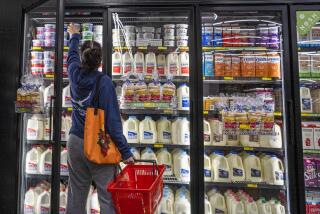Still No Inflation in Sight; July Prices Flat
- Share via
WASHINGTON — Wholesale prices were flat in July, suggesting inflation is not likely to become a problem in the near future.
The Labor Department said Friday that its producer price index was unchanged after a modest 0.2% advance in June and a decline of 0.1% in May.
The PPI, which measures cost pressures before goods reach retailers, had shot up a worrisome 0.4% in April and 0.5% in March.
“There’s no question that this is another benign inflation report,” said economist Stuart G. Hoffman of PNC Bank Corp. in Pittsburgh. “It also suggests there are no big inflation bulges building in the pipeline to spew onto the consumer level.”
He predicted the consumer price index for July will show a moderate 0.2% gain when it is released Tuesday.
Stocks and bonds initially rose on the latest sign that inflation is not threatening an economic expansion now in its sixth year.
Because of a lack of inflationary pressures and recent signs suggesting a moderating economy, many analysts believe Federal Reserve Board policymakers are likely to leave short-term interest rates unchanged when they meet Aug. 20.
With inflation in check and weakness showing up in retail, housing and auto sales, “there’s no compelling reason to raise rates now,” said Anthony Chan, chief economist at Banc One Investment Advisors Corp. in Columbus, Ohio.
Some of the latest inflation statistics “look more like recession than like 1994, when the Fed tightened,” said David Orr, an economist at First Union Corp. in Charlotte, N.C.
Moreover, Fed Gov. Susan Phillips said this week that policymakers are paying particular attention to any evidence of price increases at the producer level. That suggests that Friday’s news will weigh importantly in the Fed’s interest rate deliberations.
The latest PPI shows that wholesale prices remain contained. Food costs edged up just 0.2%, while energy prices dropped 0.9%. Excluding those volatile components, the so-called core index rose a barely perceptible 0.1%, or 0.7% annualized so far this year.
Including food and energy, which spiked earlier in the year, wholesale prices were up at an annual rate of just 1.9% during the first seven months and 2.6% over the last year. The PPI rose 2.2% during all of 1995.
In food, prices rose for beef, poultry, fish and vegetables but were partially offset by declines in the cost of pork and fruit. Prices for fruit and melons plunged 15.4%, the steepest in 25 years.
Gasoline prices, which shot up earlier this year, continued to fall back, down 2.8% in July after plunging 7.4% a month earlier. Residential electric power fell 0.8%, more than erasing a 0.4% advance in June.
Heating oil costs rose 4.4%, and natural gas was up 1.4%.
Automobile prices were down 0.9% after rising 1% in June. It was the largest decline since 1.4% in January. Light-truck prices fell 0.2%.
Prices for household appliances were unchanged; those for furniture dropped 0.1%.
Apparel prices were also contained. Girls’ clothing was up 0.2%, women’s clothing up 0.1%. Men’s and boys’ apparel prices were unchanged.
Although the index for finished goods was unchanged, farther back in the pipeline the intermediate-goods gauge fell 0.3%. The crude-goods index rose 1.2%, but excluding food and energy, it was down 1.6% for the third straight drop. (An example of finished goods would be bread; intermediate goods, flour; crude goods, wheat.)
(BEGIN TEXT OF INFOBOX / INFOGRAPHIC)
Producer Prices
Seasonally adjusted index of finished-goods prices
1982=100
July 1996: 131
More to Read
Inside the business of entertainment
The Wide Shot brings you news, analysis and insights on everything from streaming wars to production — and what it all means for the future.
You may occasionally receive promotional content from the Los Angeles Times.









